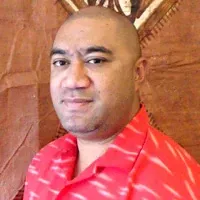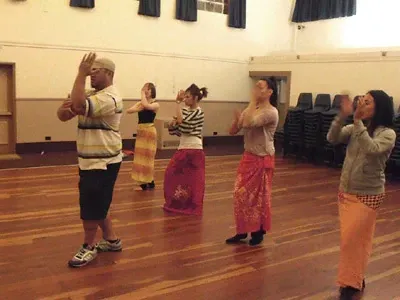Pacific Dance: Keneti Muaiava
Written by

Keneti Muaiava talks about his past, present and future as he prepares to show his Pacific Dance Artist in Residence work - based on moving from the codified movements of Samoan dance past and present and what it may look like in the future.
* * *
Thankful and nervous, that’s how Keneti Muaiava describes his newest challenge – taking on the Pacific Dance Artist in Residence for 2011. Thankful for the opportunity because it’s only the second year the residency has been around and nervous because of the expectations behind creating original pieces of work.
Keneti is a Samoan dance choreographer with a lifetime of experience. He can’t remember starting to dance but says he helped his father teach Samoan dance at De La Salle College when it was a “white school” and when he was only four years old. His dad would drum and Keneti would be the one showing groups of students how it was supposed to be done.
“I remember teaching these older guys, including John Kirwan who was a student at the time. I feel really fortunate now that my dad really gave me a good grounding. And I owe it not only to my dad but to all the parents involved back then. They all had a role…because there was no [dance] community and everyone had to highlight their own performance.”
Now, some thirty-years later, Keneti has become the master and yes, he is still teaching others how to do it. Keneti is currently the Samoan dance tutor at Auckland University’s Centre for Pacific Studies.
But, for him it all goes back to the early days and how he had the opportunity to learn a lot of “traditional” dance.
“I am very lucky, where I grew up. People ask me where do you get the moves from? I was fortunate to be exposed to all these traditional dances. It makes me able to come up with a dance and it doesn't look like a foreign art form.”
Keneti points to the importance of building a repertoire of movements and dances, which have been laid down by Samoan or Pacific dance artists/choreographers over many generations before trying to develop newer forms.
“It’s like studying history. You know. You go to University and learn about Karl Marx or something like that. The story doesn’t change. It is the same with dance. I guarantee that for example, if you went to do a course and had to learn 10 sasas from the last 30 years, then they would look totally different.”
Keneti is talking about the state of the art of Pacific dance today and the performance of dance, particularly in competitions, whereby practitioners perform what is supposed to be a heritage dance and yet the movements are “physically different” to what was practiced in the cultures of origin.
“Sometimes in these competitions it’s more like ‘Stomp the Yard.’ The movements and rhythms are totally different.”
But Keneti doesn’t blame hip-hop.
“I think that any kid today that does hip hop or does dance is an awesome thing. I'll be honest too and think that the number one thing that is important for kids is the expression and it took me awhile to realise that and it took me awhile to understand that what everyone is trying to do is just express themselves. At the same time holding on to the culture is a good thing, and if they try and stay rooted in their cultures, and stay inspired by culture, then, man, hip hop can go up to another level.”
Keneti says this especially relating to competitions such as the ASB Polyfest, which has now been going for 35 years, has its own dedicated television programme, attracts an audience close to 100,000 per year and performer numbers in the thousands. It’s the biggest dance event of its kind in Australasia and has become an institution amongst high school students in Auckland. Keneti was also a tutor for schools in the event for 15 years.
“My hope is that in future, if we look at some old footage, we can look at a 1969 sasa, it will probably be good for every school to look at exactly those actions that they did. Then maybe a sasa from 1972, then from 1981, and if we look at those three dances, then I think, everything, their vocabulary, will improve… Because I think when you watch a sasa now you're watching the state of the art, and that's not a bad thing, but, yeah, physically it is different.”
This is the base for Keneti’s work during his residency, which he has been undertaking for the past eight-weeks. His work called Past, Present, Future is based on the idea of moving from the codified movements of Samoan dance past and present and looking forward to what it may look like in the future.
During his residency he has taught a dozen or so dancers from various backgrounds three Samoan heritage dances – the sasa, ma’ulu’ulu (action dance) and the fa’ataupati (slap dance). From there he has created dances based on these traditions and their associated movements. These dances also include a music/rhythm aspect, which Keneti received mentoring as part of the residency from esteemed ethnomusicologist Dr Richard Moyle.
- Keneti’s showing of work will be showcased this weekend at Metro Theatre (Mangere East Hall), Saturday July 30th, 6pm – 7pm.
Supported by Pacific Dance New Zealand, DANZ and Creative New Zealand.
This interview by Aaron Taouma is the latest in a series of profiles from Pacific Dance New Zealand.

